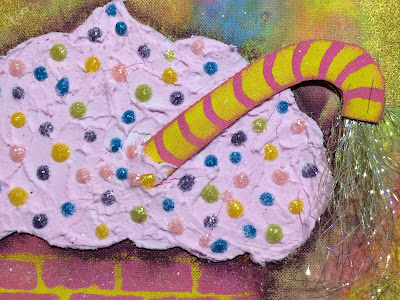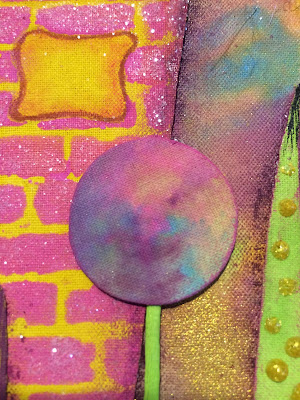Well here we are in the final week of Summer of Creative Chemistry. I am sad to see these challenges come to an end but I am excited to be part of
Creative Chemistry 103 due to start August 1st 2016.
Unfortunately, I missed Week 7 as I was busy with another project using, you guessed it, fabric and Distress. I will feature my project in an upcoming post. I will still complete the Week 7 Challenge and post the page on my blog soon.
This week the challenge was to use Distress Ink and Embossing Powders. I chose Distress Embossing Powders as I love the varied effects I can achieve with them.
I have edged my base fabric layer with Dusty Concord Distress Stain.
I created my background by layering Scattered Straw, Wild Honey and Rusty Hinge Distress Inks. I sprinkled some Dusty Concord Distress Embossing Powder randomly over my background and heat set it with an iron under my fabric. I stamped the Kaisercraft "Script" stamp with Vintage Photo Archival Ink. I stamped the dots with a stamp from the "Bitty Grunge" set by Stampers Anonymous with Distress Embossing Ink and gold embossing powder.
I painted the vase with Rusty Hinge and Forest Moss Distress Paints. After adding some decorative stitching, I sprinkled some Vintage Photo Distress Embossing Powder over the Rusty Hinge and Clear Embossing Powder over the Forest Moss. I once again heat set with an iron under my fabric. I was going for a terracotta look. I also added some Clear Embossing Powder to the inner top lip of the vase to indicate glazing. I edged the vase with Walnut Stain Distress Ink.
I printed my words onto ordinary copier paper and applied Wild Honey Distress Stain over them. I sponged some Wild Honey Distress Ink around them. I grunged them up a bit and distressed the edges with Walnut Stain Distress Ink. I created the shadow for my words and vase with Vintage Photo Distress Crayon.
I coloured the stems with Forest Moss Distress Stain. The leaves were coloured with Crushed Olive and Forest Moss Distress Markers.
The flowers were created by colouring the petals with Dusty Concord and Wild Honey Distress Inks. I then edged the petals with watered down PVA glue and dipped them into Dusty Concord Distress Embossing Powder. I heat set them with my embossing tool and the glue bubbled up and caused some pretty cool texture. It also has the added bonus of sealing the edge of the fabric.
For the flower centres, I cut a circle and covered it with watered down PVA glue and Scattered Straw Distress Embossing Powder. I heat set it and repeated the process. The release crystals became trapped in the glue and embossing giving a wonderful texture. I pounced some Wild Honey Distress Ink over the surface to add some depth.
I have so enjoyed these challenges and the wonderful effects that can be obtained using Distress products and fabric.
I am going to hold off constructing my book until after Creative Chemistry 103. I will be setting myself some more challenges as a result of those classes and adding those pages to my book.
Stay tuned for a belated Week 7 Challenge page!






























